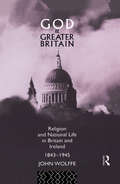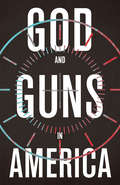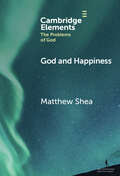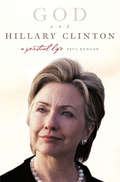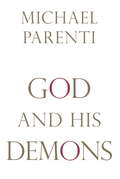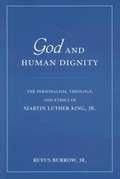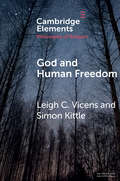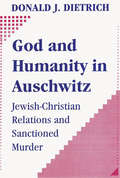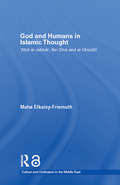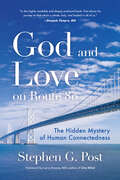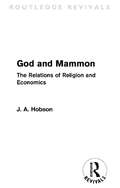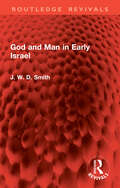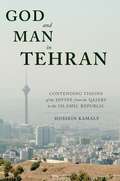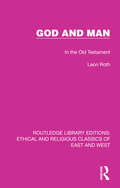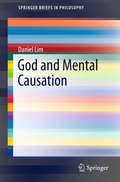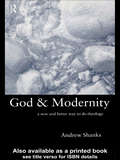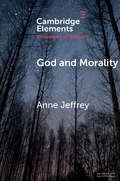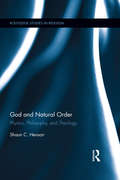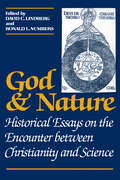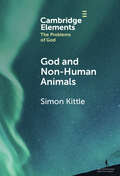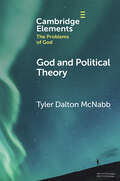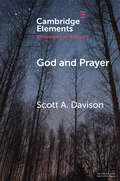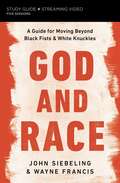- Table View
- List View
God and Greater Britain: Religion and National Life in Britain and Ireland, 1843-1945
by John WolffeConcern and debate over the role of religion in the make up of the United Kingdom is a contemporaneously relevant as it was in the nineteenth century. God and Greater Britain is a survey of the contribution of religion to society, politics, culture and national self-understanding in Britain and Ireland at a pivotal period in their historical development. It derives from primary research as well as from an extensive synthesis of the secondary literature. John Wolffe's timely and stimulating appraisal of the centrality of religion is well illustrated with specific episodes and uniquely places religion in a firm historical perspective.
God and Guns in America
by Michael W. AustinWhat if Christians did more than offer thoughts and prayers in response to gun violence? Ethicist Michael Austin argues—from a biblical but nonpacifist perspective—that we can impose firearms restrictions to make our society safer and less fearful while still respecting the rights of gun owners. God and Guns in America is a thoughtful, measured, and articulate treatment of a polarizing topic that is too often treated with more heat than light.
God and Guns in America
by Michael W. AustinWhat if Christians did more than offer thoughts and prayers in response to gun violence? Ethicist Michael Austin argues—from a biblical but nonpacifist perspective—that we can impose firearms restrictions to make our society safer and less fearful while still respecting the rights of gun owners. God and Guns in America is a thoughtful, measured, and articulate treatment of a polarizing topic that is too often treated with more heat than light.
God and Happiness (Elements in the Problems of God)
by Matthew SheaThis Element explores the connection between God and happiness, with happiness understood as a life of well-being or flourishing that goes well for the one living it. It provides a historical and contemporary survey of philosophical questions, theories, and debates about happiness, and it asks how they should be answered and evaluated from a theistic perspective. The central topics it covers are the nature of happiness (what is it?), the content of happiness (what are the constituents of a happy life?), the structure of happiness (is there a hierarchy of goods?), and the possibility of happiness (can we be happy?). It argues that God's existence has significant, positive, and desirable implications for human happiness.
God and Hillary Clinton: A Spiritual Life
by Paul KengorFor nearly three decades political observers have sought to understand the complex relationship between Hillary Clinton's faith and her politics. Now, in this first spiritual biography of the former first lady, acclaimed historian Paul Kengor sets out to answer the elusive question: What does Hillary Clinton believe? Based on exhaustive research, God and Hillary Clinton tells the surprising story of Hillary's spiritual evolution, detailing the interaction between her lifelong religious beliefs and her personal history that has made her the politician she is today. Offering an in-depth spiritual chronology of Clinton's life, author Paul Kengor also analyzes the fraught relationship between her faith and her secular policies--most notably how she reconciles her pro-choice stance on abortion with her Christian beliefs--and scrutinizes how these policies have changed over the course of her political career. What emerges is an unexpected portrait of a political figure whose ideals have been shaped by both the power of her politics and the depth of her religious devotion.
God and His Demons
by Michael ParentiNoted cultural critic and activist Parenti warns against the dangers of religion's dark side, whether the evils committed in the name of God or the hypocrisies of religious figures. Instead of condemning all believers, however, the author focuses on the exploitation of religious faithful by the powerful; on sectarian intolerance and violence; and on the reactionary collusion between leaders of church and state. Suggesting that religious fundamentalists and theocrats are a danger to democratic freedoms, Parenti documents the increasing efforts of secularists and progressive religionists to fight back against religious intolerance. Annotation ©2010 Book News, Inc., Portland, OR (booknews.com)
God and Human Dignity: The Personalism, Theology, and Ethics of Martin Luther King, Jr
by Rufus BurrowAlthough countless books have been devoted to the life and work of Martin Luther King, Jr. , few, if any, have focused on King's appropriation of, and contribution to, the intellectual tradition of personalism. Emerging as a philosophical movement in the early 1900s, personalism is a type of philosophical idealism that has a number of affinities with Christianity, such as a focus on a personal God and the sanctity of persons.
God and Human Freedom (Elements in the Philosophy of Religion)
by Leigh C. Vicens Simon KittleThis Element considers the relationship between the traditional view of God as all-powerful, all-knowing and wholly good on the one hand, and the idea of human free will on the other. It focuses on the potential threats to human free will arising from two divine attributes: God's exhaustive foreknowledge and God's providential control of creation.
God and Humanity in Auschwitz: Jewish-Christian Relations and Sanctioned Murder
by Donald DietrichGod and Humanity in Auschwitz synthesizes the findings of research developed over the last thirty years on the rise of anti-Semitism in our civilization. Donald J. Dietrich sees the Holocaust as a case study of how prejudice has been theologically enculturated. He suggests how it may be controlled by reducing aggressive energy before it becomes overwhelming. Dietrich studies the recent responses of Christian theologians to the Holocaust and the Jewish theological response to questions concerning God's covenant with Israel, which were provoked by Auschwitz.Social science has dealt with the psychosocial dynamics that have supported genocide and helps explain how ordinary persons can produce extraordinary evil. Dietrich shows how this research, combined with theological analyses, can help reconfigure theology itself. Such an approach may serve to help dissolve anti-Semitism, to aid in constructing such positive values as respect for human dignity, and to point the way to restricting future outbreaks of genocide.God and Humanity in Auschwitz surveys which religious factors created a climate that permitted the Holocaust. It also illuminates what social science has to tell us about developing a strategy that, when institutionally implemented, can channel our energies away from sanctioned murder toward a more compassionate society. The book has proven to be an essential resource for theologians, sociologists, historians, and political theorists.
God and Humans in Islamic Thought: Abd Al-Jabbar, Ibn Sina and Al-Ghazali (Culture and Civilization in the Middle East)
by Maha Elkaisy-FriemuthWinner of The Iranian World Prize for the Book of the Year 2007 in the Philosophy and Mysticism category. This new and original text provides a timely re-examination of Islamic thought, presenting a stark contrast to the more usual conservative view. The explanation of the relationship between God and humans, as portrayed in Islam, is often influenced by the images of God and of human beings which theologians, philosophers and mystics have in mind. The early period of Islam reveals a diversity of interpretations of this relationship. Elkaisy-Friemuth discusses the view of three scholars from the tenth and eleventh century: Abd al-Jabbar, Ibn Sina and Al-Ghazali, which introduce three different approaches of looking at the relationship between God and Humans. God and Humans in Islamic Thought attempts to shed light on an important side of medieval rational thought in demonstrating its significance in forming the basis of an understanding of the nature of God, the nature of human beings and the construction of different bridges between them.
God and Logic in Islam
by John WalbridgeThis book investigates the central role of reason in Islamic intellectual life. Despite widespread characterization of Islam as a system of belief based only on revelation, John Walbridge argues that rational methods, not fundamentalism, have characterized Islamic law, philosophy, and education since the medieval period. His research demonstrates that this medieval Islamic rational tradition was opposed by both modernists and fundamentalists, resulting in a general collapse of traditional Islamic intellectual life and its replacement by more modern but far shallower forms of thought. However, the resources of this Islamic scholarly tradition remain an integral part of the Islamic intellectual tradition and will prove vital to its revival. The future of Islam, Walbridge argues, will be marked by a return to rationalism.
God and Love on Route 80: The Hidden Mystery of Human Connectedness
by Stephen G. Post#1 New Release in Mysticism, Miracles & Philosophy - A Story of Faith, Love, and Destiny for Everyone on a Spiritual JourneyOnce every generation comes a book so revelatory and lucid, it reconnects us to our very souls. Stephen G. Post’s God and Love on Route 80 is such a book. Post, lead author of the bestselling When Good Things Happen to Good People, was the perfect child and A-student until he took off in the family car, compelled by a persistent vision, his “blue angel dream.” Crossing America on Route 80, his unlikely adventure culminates in a shocking encounter that sets the stage for the rest of his life, a path connected by synchronicities which Post perceived as guidance from God and proof of humanity’s fundamental oneness, Infinite Mind. Truly a story for the ages, God and Love on Route 80 touches on the essential meaning of life and the messages we may all miss unless we begin paying close attention.There are no coincidences in this world. God and Love on Route 80 is the highly entertaining true story of a cross-country road trip and a spiritual journey that led one young man to the discovery that a powerful force carries us toward our destinies. Many scriptures teach of an eternal, Infinite Mind beyond space and time that creates and sustains the universe. The divine Mind whispers and winks at us as we move through our everyday lives to reassure us that the journey is meaningful after all, even when we stumble.The goodness of the universe is greater than ourselves. This book is for dreamers and questers of any spirituality who are looking for positive meaning and purpose in life. On the road, we can find God, redemption, forgiveness, and the understanding that we are all connected.Readers inspired by modern classics such as Peace Like a River, Becoming Supernatural and When God Winks at You will love God and Love on Route 80.
God and Mammon: The Relations of Religion and Economics (Routledge Revivals)
by J. A. HobsonFirst published in 1931, this is an attempt by the great economist J. A. Hobson to analyse the relations between economics and religion. After considering the origins of the conflicts and compromises between God and Mammon in the life of primitive man, the author concerns himself primarily with medieval and modern Christianity and the business climate and ethos corresponding with these periods. In particular he focuses upon Catholicism and Protestantism, before considering the attitude of the church towards modern economic movements.
God and Man in Early Israel (Routledge Revivals)
by J. W. SmithFirst published in 1956, God and Man in Early Israel deals with Old Testament history from Abraham to Solomon in the light of modern archaeological research and biblical scholarship, and in terms of the Christian belief in divine revelation. The book is divided into three parts—God and Man in the stories of the Patriarchs; God and Man in the making of a Nation; and God and Man in the founding of a Kingdom. Biblical references are given throughout the book. God and Man in Early Israel is intended as a companion to the study of the Bible, not as a substitute for it. It will be a fascinating read for students and researchers of religion, history, and classics.
God and Man in Tehran: Contending Visions of the Divine from the Qajars to the Islamic Republic
by Hossein KamalyIn God and Man in Tehran, Hossein Kamaly explores the historical processes that have made and unmade contending visions of God in Iran’s capital throughout the past two hundred years. Kamaly examines how ideas of God have been mobilized, contested, and transformed, emphasizing how notions of the divine have given shape to and in turn have been shaped by divergent conceptualizations of nature, reason, law, morality, and authority.The book analyzes official government policies, modern textbooks, and university curricula; popular beliefs and ritual practices; and philosophical and juridical attitudes toward theological questions in traditional institutions. Kamaly considers continuity and change in religiosity under the Qajar and Pahlavi dynasties; the significance of outbreaks of messianic expectations; why a modernizing nation took a sudden turn toward state religiosity; and how the Islamic Republic deploys visions of God against foreign enemies and domestic critics. Beyond the majority Shia Muslim population, the book includes minority and suppressed voices. With a focus on the diversity of ideas of the divine, God and Man in Tehran offers a novel perspective on the intellectual movements that have shaped Iranian modernity.
God and Man: In the Old Testament (Ethical and Religious Classics of East and West #7)
by Leon RothOriginally published in 1955, and containing some 500 passages, this Biblical anthology brings together, in their original wording, the highest expressions of the Biblical view of life. The anthology is non-historical and non-doctrinal. It starts with the confrontations of man with God as seen in the ‘calls’ of the prophets, and proceeds to the ways of life demanded of man and the duties accompanying the privilege of vocation. It ends with the visions of the ideal society which in times of trial the author believes have sustained the mind. When this was first published, the anthology used often forgotten texts, and in so doing stimulated much attention to these enduring religious documents.
God and Mental Causation
by Daniel LimThis book lies at the intersection of philosophy of mind and philosophy of religion and operates on the assumption that dialogue between the two disciplines can be fruitful. In particular it focuses on how debates in the philosophy of mind regarding the nature of mental causation relate to debates in the philosophy of religion regarding divine action, creaturely causation, and existence of God. The book is divided into two parts. The first deals with Jaegwon Kim's so-called Supervenience Argument (SA) against non-reductive physicalism. One important observation is that the structural similarities between non-reductive physicalism and 'orthodox' theism make it convenient to co-opt non-reductive physicalist solutions to the SA in defending the possibility of creaturely causation in the philosophy of religion. The SA is used as a foil to discuss the relative merits of Malebranche's so-called Conservation is Continuous Creation Argument for Occasionalism (CCCA). Moverover, the so-called compatibilist strategy (Karen Bennett 2003, 2009) for developing a non-reductive physicalist response to the Supervenience Argument is defended and developed. This strategy is then deployed in the philosophy of religion to defend the possibility of creaturely causation against the CCCA.
God and Modernity: A New and Better Way To Do Theology
by Andrew ShanksFor the past four hundred years, theological debate has been dominated by a fundamental divide: between the liberals, with strong loyalties to the secularity of the secular state and university on the one hand, and the neo-orthodox, insisting on the absolute priority of a proper loyalty to the church community itself, on the other. God and Modernity strikes off in a fundamentally new directionAndrew Shanks boldly calls for a new and better way to do theology.Shanks argues that God is most present in a culture where public debate over ethical issues flourishes best. Social movements such as feminist movements, peace movements, and green movements have emerged to challenge both Church and State. These new movements are no longer confined to a particular confessional religious identity and are independent of state sponsorship. These social movements already made an individual impact on theology. What would a theology look like, systematically trying to reconcile older divisions in the theological debate with a new loyalty to such movements common ethos?Anyone wishing to gain a refreshing insight into a new way of understanding theology and politics will welcome this ground-breaking book.
God and Morality (Elements in the Philosophy of Religion)
by Anne JeffreyThis Element has two aims. The first is to discuss arguments philosophers have made about the difference God's existence might make to questions of general interest in metaethics. The second is to argue that it is a mistake to think we can get very far in answering these questions by assuming a thin conception of God, and to suggest that exploring the implications of thick theisms for metaethics would be more fruitful.
God and Natural Order: Physics, Philosophy, and Theology (Routledge Studies in Religion)
by Shaun C. HensonIn God and Natural Order: Physics, Philosophy, and Theology, Shaun Henson brings a theological approach to bear on contemporary scientific and philosophical debates on the ordered or disordered nature of the universe. Henson engages arguments for a unified theory of the laws of nature, a concept with monotheistic metaphysical and theological leanings, alongside the pluralistic viewpoints set out by Nancy Cartwright and other philosophers of science, who contend that the nature of physical reality is intrinsically complex and irreducible to a single unifying theory. Drawing on the work of theologian Wolfhart Pannenberg and his conception of the Trinitarian Christian god, the author argues that a theological line of inquiry can provide a useful framework for examining controversies in physics and the philosophy of science. God and Natural Order will raise provocative questions for theologians, Pannenberg scholars, and researchers working in the intersection of science and religion.
God and Nature: Historical Essays on the Encounter between Christianity and Science
by Ronald L. Numbers David C. LindbergSince the publication in 1896 of Andrew Dickson White's classic History of the Warfare of Science with Theology in Christendom, no comprehensive history of the subject has appeared in the English language. Although many twentieth-century historians have written on the relationship between Christianity and science, and in the process have called into question many of White's conclusions, the image of warfare lingers in the public mind.To provide an up-to-date alternative, based on the best available scholarship and written in nontechnical language, the editors of this volume have assembled an international group of distinguished historians. In eighteen essays prepared especially for this book, these authors cover the period from the early Christian church to the twentieth century, offering fresh appraisals of such encounters as the trial of Galileo, the formulation of the Newtonian worldview, the coming of Darwinism, and the ongoing controversies over "scientific creationism." They explore not only the impact of religion on science, but also the influence of science and religion.This landmark volume promises not only to silence the persistent rumors of war between Christianity and science, but also serve as the point of departure for new explorations of their relationship, Scholars and general readers alike will find it provocative and readable.
God and Non-Human Animals (Elements in the Problems of God)
by Simon KittleThis Element explores the relevance of non-human animals to theology. It suggests that while Christian theology has so far been a thoroughly anthropocentric discipline, there are good reasons for treating animals as subjects worthy of theological reflection in their own right. The Element considers animals in the context of Christian ethics, investigates whether the violence and suffering found in evolutionary processes can be reconciled with a good God, and surveys some of the ways key theological doctrines may need to be altered in the light of what contemporary science teaches about human animals and non-humans.
God and Political Theory (Elements in the Problems of God)
by Tyler Dalton McNabbHow is God related to the state? Could the existence of robust political authority somehow be evidence for God? In this Element, the author explores these questions, pro and con, looking at various major positions. At the start of the volume, they defend a political argument for God's existence. Having motivated a theistic account of political authority, they then discuss the role God plays or could play in classical liberalism, Marxism, and postliberalism. While they sympathetically survey each political theory in turn, at the end of each section, they raise various objections to the view being discussed. Finally, at the end of the Element, the author articulates desiderata for theists who are looking for political frameworks.
God and Prayer (Elements in the Philosophy of Religion)
by Scott A. DavisonAre there good reasons for offering petitionary prayers to God, if God exists? Could such prayers make a difference in the world? Could we ever have good reason to think that such prayers had been answered? In this Element, the author will carefully explore these questions with special attention to recent philosophical discussions.
God and Race Study Guide plus Streaming Video: A Guide for Moving Beyond Black Fists and White Knuckles
by John Siebeling Wayne FrancisThis Study Guide includes:Individual access to 5 streaming video sessionsDiscussion and reflection questions with video notesPersonal study between sessionsLeader&’s GuideA recent Pew Research study discovered that 6 out of 10 adults in America believe racial tension is a major problem in this country—and one that is only growing worse. Today, people across the nation are dealing with tensions between blacks and whites, and often this tension breaks out into violence. People are talking about the issue; but sadly, the church has been reluctant to engage in the discussion.In God and Race, pastors Wayne Francis and John Siebling seek to provide a non-threatening means for pastors, church leaders, and churchgoers to start to dialogue about this important issue. Wayne Francis, lead pastor of The Life Church in New York, speaks to the "Black Fist" part, showing how the racism that blacks have faced have led to many solidarity movements that have served to increase racial tensions in our country. John Siebling, lead pastor of The Life Church in Memphis, Tennessee, speaks to the "White Knuckles" part, showing how many whites today are "white-knuckling" it to try and hold on to old (and wrong) ways of thinking . . . or are just tensing up when approached with the issue and hoping that it will just go away.In this study, Wayne and John show how neither black fists or white knuckles are the answer to the problem, but that what is needed are open hands, open hearts, and open minds. They do this by discussing seven key statements that they believe the church needs to acknowledge today:Racism is a problemThe gospel is the solutionIt's more than just a spiritual problemIt's complicatedWhite people must understand and acknowledge the sin of slavery and mistreatment of black peopleBlack people in turn have to forgive white people of previous and present injustices, while also not harboring hatred and racism toward white peopleUnless we make a solid intentional choice to connect, understand, reach, and love one another, we will remain dividedIn the Gospels, we see how the crowds came to Jesus because he talked about real issues and was not afraid to engage in the important issues of his day. In the church of today, we need to be doing the same, for it is only by recognizing, addressing, and openly dialoguing about the racial tension in America that we can together begin to work toward real solutions. Wayne and John have no presumption in this series that they are going to solve the issue. Rather, their goal is to have churches follow their example and start the conversion in their congregations.
